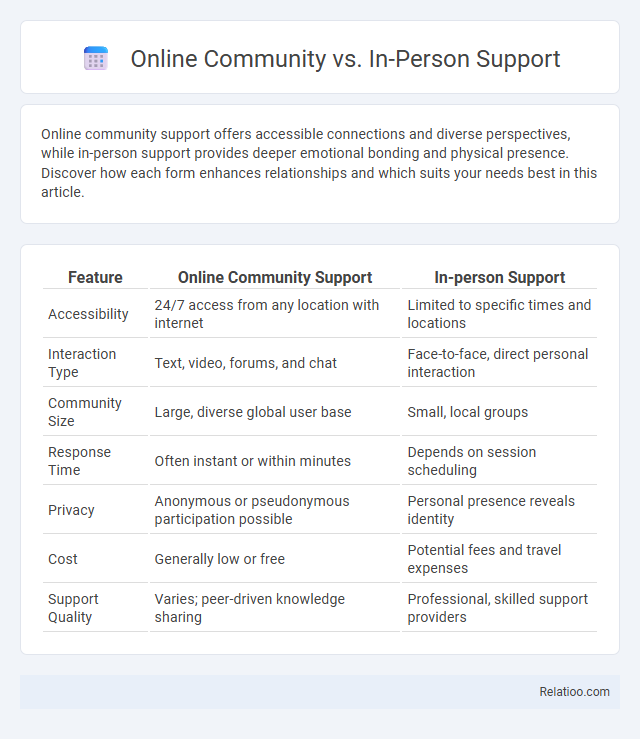Online community support offers accessible connections and diverse perspectives, while in-person support provides deeper emotional bonding and physical presence. Discover how each form enhances relationships and which suits your needs best in this article.
Table of Comparison
| Feature | Online Community Support | In-person Support |
|---|---|---|
| Accessibility | 24/7 access from any location with internet | Limited to specific times and locations |
| Interaction Type | Text, video, forums, and chat | Face-to-face, direct personal interaction |
| Community Size | Large, diverse global user base | Small, local groups |
| Response Time | Often instant or within minutes | Depends on session scheduling |
| Privacy | Anonymous or pseudonymous participation possible | Personal presence reveals identity |
| Cost | Generally low or free | Potential fees and travel expenses |
| Support Quality | Varies; peer-driven knowledge sharing | Professional, skilled support providers |
Understanding Online Communities
Understanding online communities reveals their unique ability to provide 24/7 support, diverse perspectives, and anonymity that can enhance your emotional safety. Unlike in-person support, online communities offer scalability and accessibility, connecting you with others who share niche interests or experiences regardless of geography. Relatability in these digital spaces often stems from shared language and personal stories, creating empathetic bonds that can sometimes surpass traditional face-to-face interactions.
Exploring In-person Support Networks
Exploring in-person support networks offers You direct, face-to-face interactions that foster deeper emotional connections and trust compared to online communities. These networks provide immediate, physical presence and non-verbal cues that enhance empathy and understanding during challenging times. In-person support groups often create a sense of belonging and accountability that can be harder to replicate with virtual platforms.
Key Differences: Online vs In-person Support
Online community support offers accessibility and anonymity, allowing individuals to connect across geographical boundaries and share experiences in real-time or asynchronously. In-person support provides immediate emotional cues, non-verbal communication, and physical presence that fosters deeper personal connections and trust. The key difference lies in online support's convenience and broad reach versus in-person support's richness in empathetic engagement and direct interaction.
Accessibility and Convenience
Online community platforms provide unparalleled accessibility and convenience, enabling users to connect with support networks anytime and from any location with internet access. In-person support offers direct human interaction and immediate emotional responsiveness but often involves logistical challenges such as travel and scheduling. Relatability within online communities benefits from diverse and widespread participation, while in-person support relies heavily on proximity and shared local experiences.
Building Trust and Relationships
Online communities foster trust through continuous, accessible interaction and shared experiences that enhance relatability, enabling members to form meaningful connections despite physical distance. In-person support provides tangible presence and immediate emotional cues, strengthening trust and rapport through direct interpersonal communication and shared environments. Relatability bridges both settings by promoting empathy and understanding, crucial for building authentic relationships and sustaining long-term support networks.
Communication Styles and Effectiveness
Online communities utilize asynchronous communication, enabling diverse global interactions but sometimes lacking emotional nuance, whereas in-person support relies on synchronous, face-to-face exchanges that enhance empathy and immediate feedback. Relatability in communication often depends on shared experiences and cultural context, which are more easily conveyed and perceived in person through nonverbal cues. Effectiveness varies as online platforms facilitate broader reach and resource sharing, but in-person support typically fosters deeper trust and understanding through richer interpersonal dynamics.
Privacy and Confidentiality Concerns
Online community platforms offer your best option for privacy, utilizing encryption and anonymous profiles to protect confidentiality better than in-person support groups, which may risk social exposure. In-person support provides face-to-face empathy but often lacks strict confidentiality measures, making sensitive discussions more vulnerable to unintended disclosure. Relatability enhances emotional connection but must be balanced with stringent privacy controls, as sharing personal experiences online can expose you to data breaches or identity misuse.
Emotional Impact and Mental Wellbeing
Online community platforms offer immediate emotional support and a sense of belonging that can alleviate feelings of isolation, positively influencing Your mental wellbeing. In-person support provides tangible connection through face-to-face interactions, enhancing empathy and fostering deeper emotional bonds that are crucial for long-term emotional health. Relatability bridges both settings by creating shared experiences and understanding, which significantly boosts resilience and emotional healing in challenging times.
Scalability and Reach of Support
Online communities offer unparalleled scalability, connecting thousands globally without geographic constraints, unlike in-person support limited by physical location and attendee capacity. The reach of support in online platforms extends to diverse demographics, enabling real-time, round-the-clock interaction, which significantly enhances accessibility and immediacy. Relatability can be amplified online by algorithm-driven matching and niche group formation, broadening personalized support beyond the confines of local communities.
Choosing the Right Support for Your Needs
Choosing the right support depends on personal preferences and specific needs, with online communities offering diverse perspectives and 24/7 accessibility. In-person support provides direct human connection and immediate emotional feedback, beneficial for deeper relational experiences. Relatability in both settings enhances trust and comfort, making it crucial to consider which environment aligns best with your support goals and lifestyle.

Infographic: Online Community vs In-person Support
 relatioo.com
relatioo.com